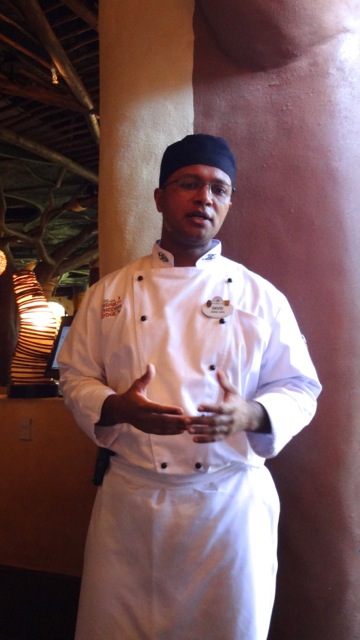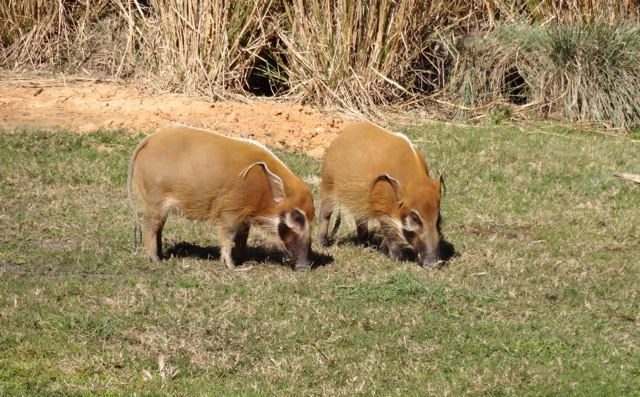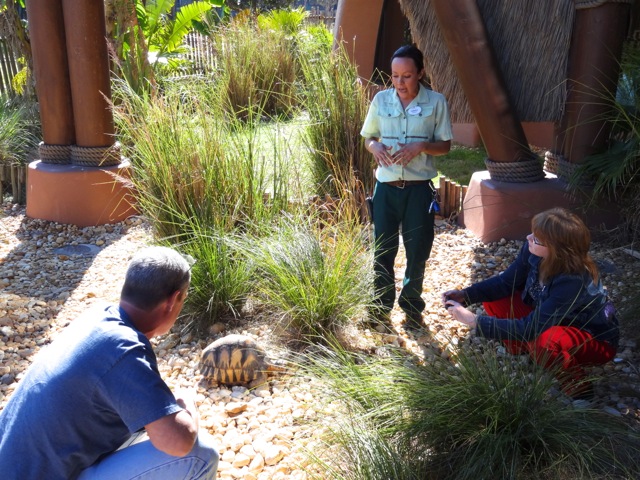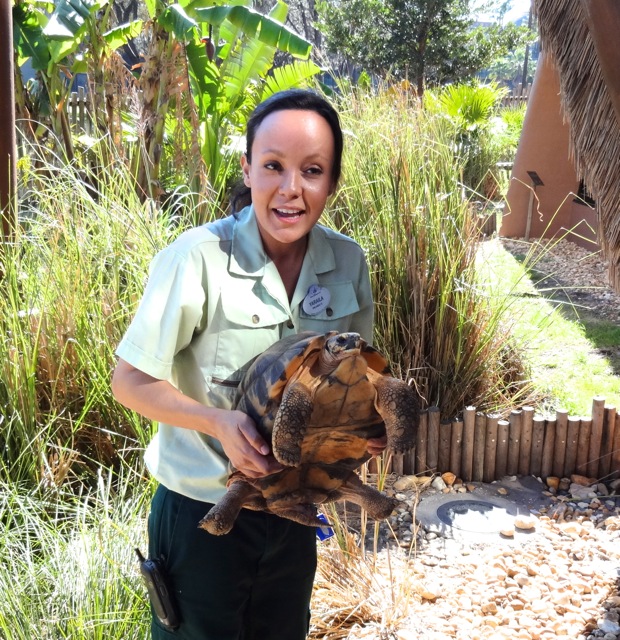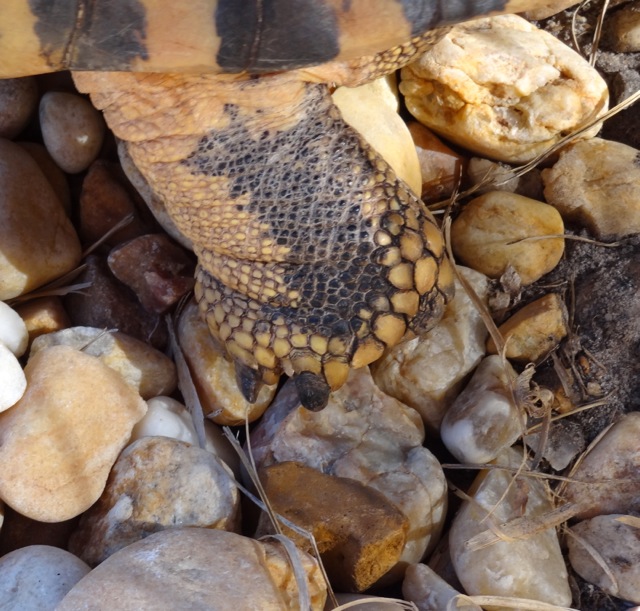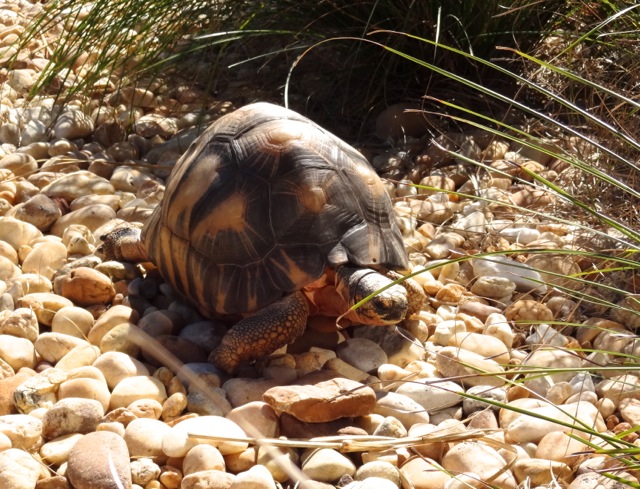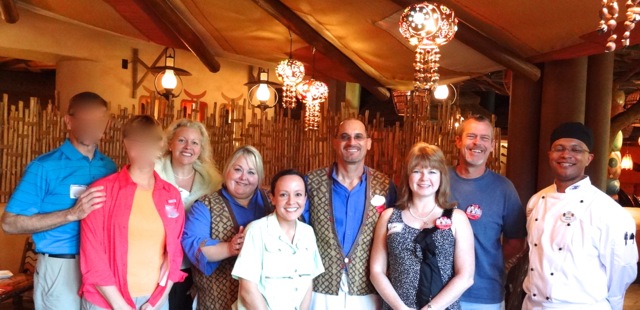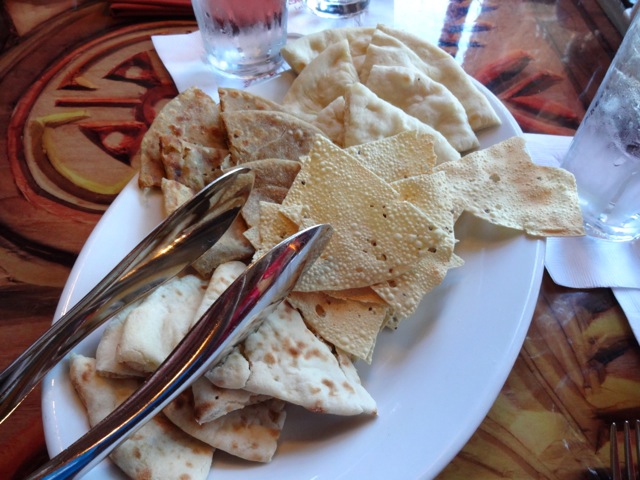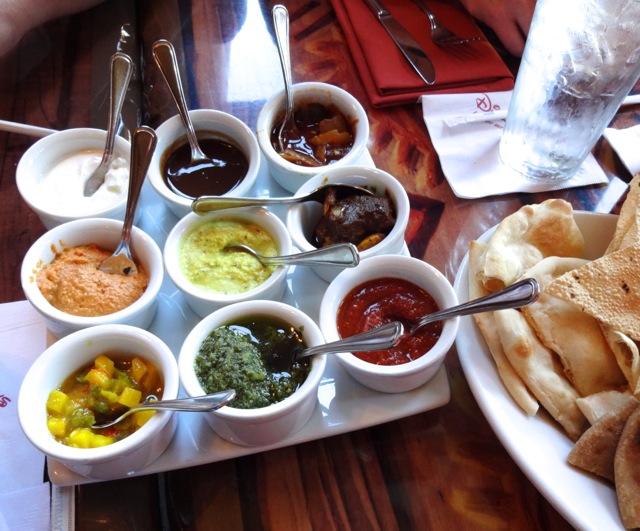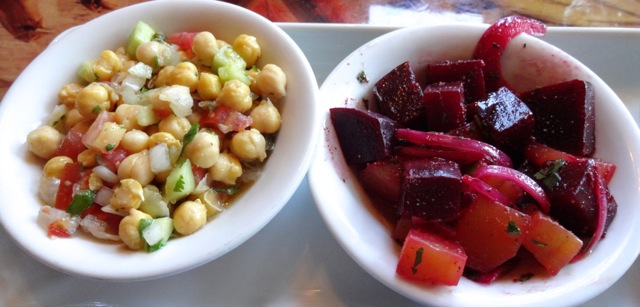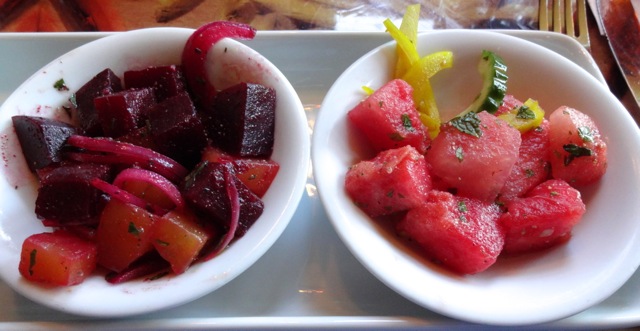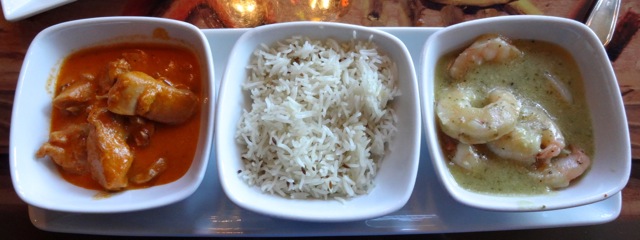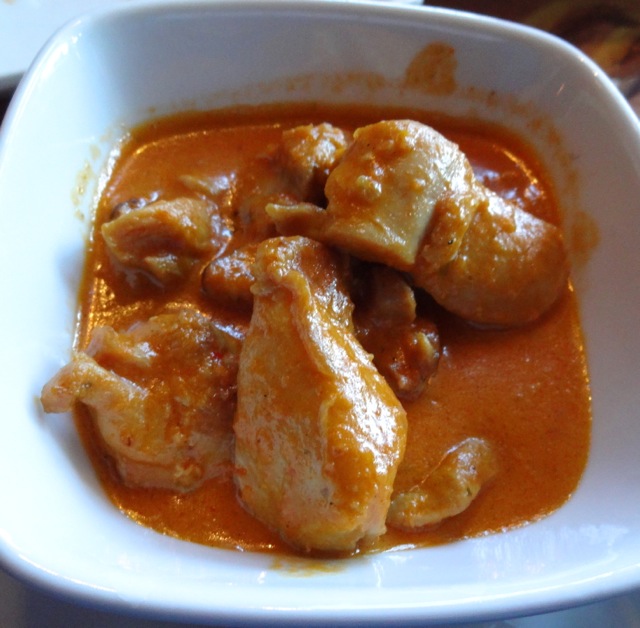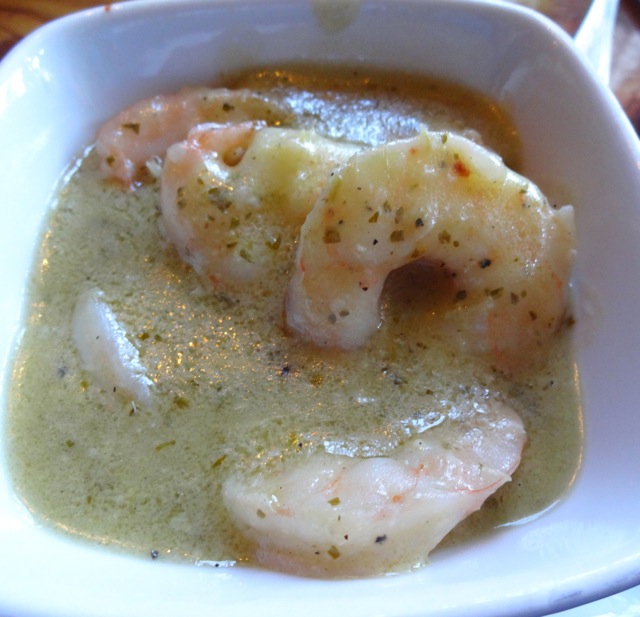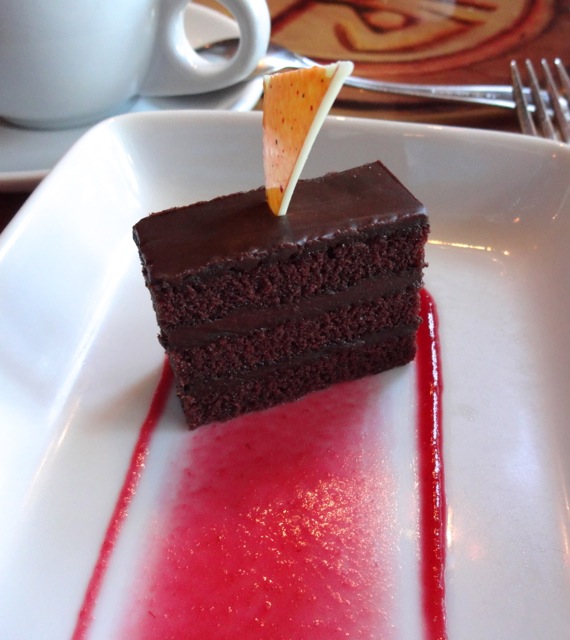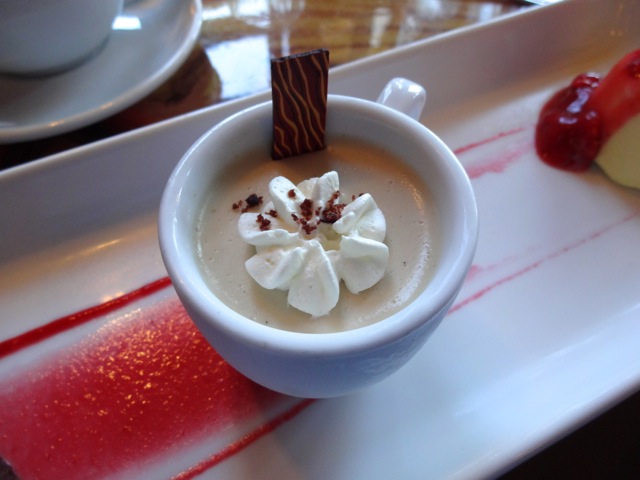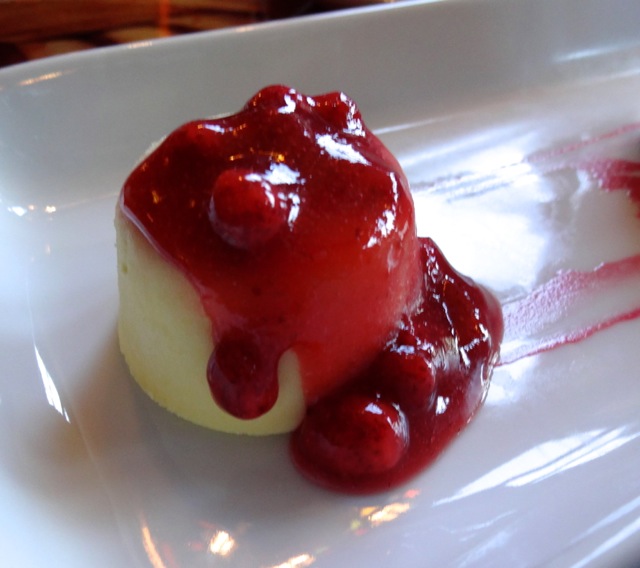We recently went to the “Dine with an Animal Specialist” luncheon at Sanaa, Kidani Village.
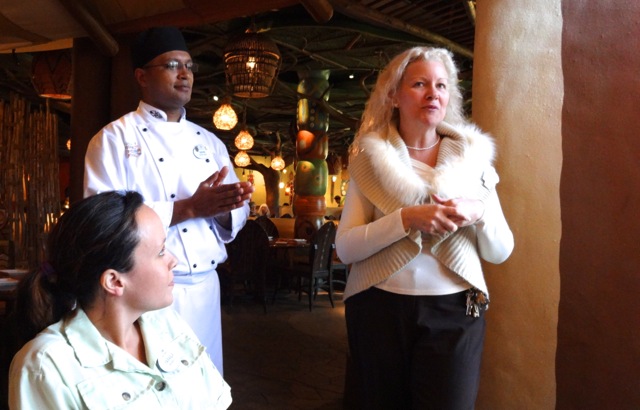
Yaraila, our animal specialist; David Njorge, head chef at Sanaa; and Stephanie Galvanga, manager at Sanaa
Yaraila was our animal specialist, she works in animal husbandry at the Pembe Savannah. Yaraila has been at Disney’s Animal Kingdom Lodge and Villas for nearly 10 months and this was her first solo luncheon. There were four guests (including the two of us), so it was a very nice intimate luncheon with lots of talking and questions and fun.
Before they began bringing out the food, we were seated and Danielle (our server) came by and asked for drink orders [yes, this is the same Danielle that waited on us a few days earlier]. Stephanie (the manager) and David (the chef) came out and welcomed us to Kidani Village and to Sanaa.
Stephanie pointed out the large number of artifacts on display (she said that the beaded aprons were gifts from the villages of brides and grooms, one village/family would work on the apron, then it would go to the other village/family and they’d add to it, the apron would travel back and forth until completed and until the wedding). Additionally, we were told that Disney’s Animal Kingdom Lodge and Villas has the largest collection of African artifacts on display (The Smithsonian has more artifacts, but not as many on display).
Chef David explained that much of the food at Sanaa is served family-style because of the cultures the food comes from. Then he explained what we’d be having for our luncheon (more about the food later).
We were served food throughout the luncheon and it was accompanied by great conversation and learning.
Yaraila’s first job ever was working at Cosmic Rays at Magic Kingdom. When she finished high school, she went to University of Florida and completed a degree in business; after a while in retail, she went back to school and got an Animal Technology degree. She had decided that she really wanted to be hands-on and work with exotic animals (veterinarians aren’t as hands-on as she wanted and she didn’t really want to focus on sick or injured animals). She did an internship at a small zoo in Northern Florida (White Oak Animal Plantation’s Animal Conservation Center) and was very fortunate to come to Animal Kingdom Lodge when her internship finished. BTW her favorite animals are rhinoceros.
There are four savannahs at Disney’s Animal Kingdom Lodge and Villas – the Pembe Savannah (6 acres) is only visible or approachable from Kidani Village, the Sunset Savannah (16 acres) is accessible from both Kidani Village and Jambo House, the Arusha Savannah (11 acres) and the Uzima Savannah (11 acres) are only accessible from Jambo House. The Pembe Savannah is Yaraila’s Savannah.
- The animal keepers tend to stay with one savannah, that way there’s better opportunity to “learn” the animals and thus more likelihood of caring for them completely
- The animals rarely move from one savannah to another
- There are 12 keepers on duty at Pembe & Sunset and another 12 at Arusha & Uzima
- Just like at Disney’s Animal Kingdom Theme Park, the savannahs are part of the American Zoological Association (AZA) and thus they particpate in Species Survival Plans to help stop interbreeding and to help invigorate the breeding stock
- All of the savannah animals are trained to auditory cues
Well, what about the day to day routine of being an Animal Handler at Animal Kingdom Lodge & Villas?
- You work 4 ten-hour days, then you’re off for 3 days
- Your shift time changes slightly… Twice you’ll be working from 7am to 6pm and then your next two rotations will be 5am to 4pm (this is the feeding rotation)
- There is a barn at each savannah and all the animals come in for 2 hours per day for feeding and looking-over (yes, that means that the animals are out on the savannahs for 22 hours each day),
- For Pembe savannah, the animals come in at 5:30 in the morning, they’re feed dry grain and they get checked-out
- This is also when they’re likely to get training and enrichment
- Any work that needs to be done on the savannahs is done during this time (guests tend to be away & not watching and the animals are not on the savannahs)
- Training is a constant activity, most of it is focused on making husbandry less worrisome for animal and human handler; for example…
- getting the animals to walk onto scales for being weighed,
- getting them to where they’ll let the handlers get in close contact ,
- getting the hoof stock trained to go into chutes for examination and treatment
- After barn time is over, the animal handlers have a 20-30 minute meeting and then their day’s work begins… clean the barn, clean the savannah (pick up feces from the savannah), clean equipment, and clean some more
So, then we learned more about the Pembe Savannah…
- Most of the animals there are hoof stock and it’s important to be really familiar with them because hoof stock are very good at masking any pain or discomfort or illness (they’re PREY and the masking keeps them alive in the wild)
- Most of the enrichment the hoof stock get is food
- Pembe has 3 adult Okapi (the only savannah at Animal Kingdom Lodge and Villas to have okapi) – okapi tend to be shy and secretive, they must be actively socialized in the zoo environment; the female okapi is pregnant
- Pembe does most of the breeding for four species
- This brought up the question, what if a mother rejects her infant; will another female care for the infant and feed it? Nope. They have to be hand raised… While Yaraila was at White Oak, she got to help hand raise a white rhino and 2 cheetah cubs
- The Nyala at Kidani are also pretty unique. Yaraila says that they can be quite mischievous
- The African Hornbills are also mischievous, well the adult male is – he has a fixation on shoes and tires, he also likes to jump into the vehicles and steal things; the male chick (Alfred) is developing some of his father’s traits, but so far they can’t determine if it’s learned behavior or hereditary
- Nick asked about the East African Cranes (you can see them very easily from inside Sanaa)
- There are 7 adult males on Pembe and Sunset savannahs
- The food for the cranes is kept behind the hot-blossoms to keep the giraffe from eating it
- Although they feel the slight electric shock of the hot-blossoms, it doesn’t bother feathered animals as much as furred animals
- The male that’s so showy? That’s Rueben
- There are 3 red river hogs on Pembe and 2 on Arusha
- They receive more training, because they’re really smart and the training helps keep them occupied
- They will crate-up much like a pet dog
- The handlers have to plan ahead when working with the red river hogs because they’ll be one step ahead of you when working with them
- They’re “super into enrichment” – the handlers use Boomer Balls (the big balls you see the tigers playing with at the theme park), buried treats, and Kongs (the dog toy that you can stuff with things to make it more interesting)
- There are 3 Hartman Mountain Zebra on Pembe savannah
- You don’t see these very often in zoos
- Their coloration is different from other zebra and their striping is different
- They have differently shaped feet because they’re from rocky, mountainous areas
After lunch, we went out to the tortoise area and met Mr Smitch – he’s one of two Radiated Madagascar Tortoises at Kidani Village. Both of them were pets and were rescued and put into care at the zoo.
- The radiated tortoises are the most endangered animals at Animal Kingdom Lodge & Villas
- How can you tell a tortoise from a land-dwelling turtle? The dome shaped carapace and the elephantine feet
- The tortoises are strict vegetarians, they do get egg occasionally, they’re fed 6 days a week
- They’re very temperature sensitive – they have a heated hut that they can go in when the temperatures drop below 55 degrees F and they stay in the hut if it gets below 50 degrees F
- How can you tell a male tortoise from a female tortoise? The males have a concave belly plate so that they don’t fall off when mating AND they have a longer gular (kind of like a chin plate on the lower shell) that they use for fighting other males (flipping them over)
And does Yaraila like working at Disney as an animal handler (when she graduated high school she just wanted to get as far away from Orlando as possible)? Yes! Walt Disney World the pinnacle for zookeepers!
Now… On to the FOOD
As often done at Sanaa, the first course was the bread service…
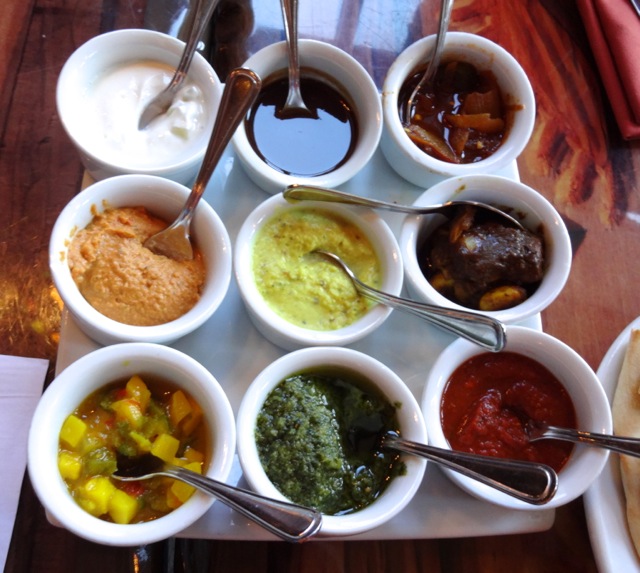
Top to bottom then left to right: MILDEST = cucumber raita, roasted red bell pepper hummus, and mango chutney; MEDIUM = tamarind chutney, coconut chutney, and coriander chutney; and HOTTEST = spicy jalapeno-lime pickle, garlic pickle, and red chile sambal
Nora’s favorites fall into the “hottest” category, she also thought that the coconut chutney, the roasted red pepper hummus and the mango chutney were quite good… but her favorite is the garlic pickle. Nick tried all of the sauces, there was nothing that he really disliked, but he agreed that the spicier ones that we usually order were his favorites.
We were given three salads for the salad course…

Salad Service: Chickpeas with cucumber and tomato, Roasted beets, and Watermelon plus cucumber and fennel
These were good (well, they’re always good), even a touch better than usual (they weren’t refrigerator cold as they can sometimes be). As you probably know, we can make a meal of the bread service and the salads at Sanaa… but not today…
The main course “Slow Cooked in Gravy, Simple and Well Seasoned”…
We were both surprised by how much we liked the butter chicken (chicken cooked in butter and cream with a mild curry sauce), of course the calorie count is probably off the charts, but this is definitely something we’d recommend to anyone with more timid taste buds. Nora thinks we’ve ordered the green curry shrimp before and nick says he doesn’t remember if we did, probably for good reason after eating it again. Simply put, it’s not as spicy or as flavorful as we expect given the ingredients and the spices put into the sauce. That said, the shrimp were expertly cooked, not overdone or underdone – and the sauce certainly doesn’t overpower them. The basmati rice with cumin seeds was good, it was cooked properly and the cumin seeds had a little “crunch” to them.
Last course (and we’re getting very full!)… Dessert
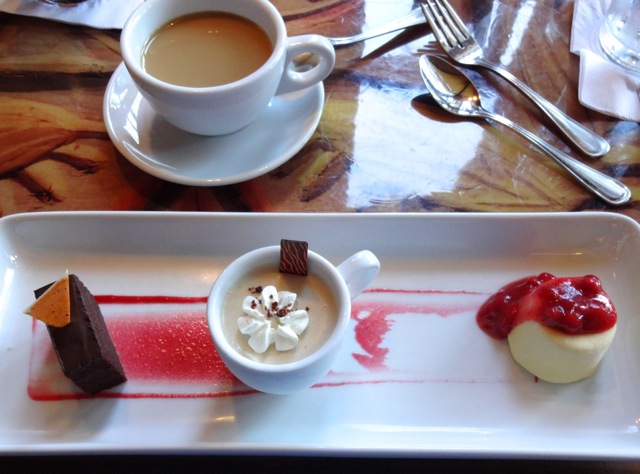
Dessert Service: Chocolate Cake, Chai seasoned Pot de Creme, Tropical Fruit Kofi topped with Macerated Strawberries
These were all good, even the chocolate cake (which can often be a cop-out), but the stellar dessert in this line-up is the chai cream. Oh man, our mouths water thinking about it. A nice blend of spiciness and creaminess, yum yum yum. We’re not certain, but this doesn’t seem to be on the menu as a stand-alone item…
Final Thoughts
- Would we do this again? Most definitely, the food was excellent and since different Animal Specialists do this, it would be nice to see who we lunched with the next time
- Is this a good value for your time and money while on vacation? Yes! This luncheon was reasonably priced for the quantity and quality of the food (roughly $50 per person)
All-in-all, this is an experience that we’re eager to repeat and to share with friends.
